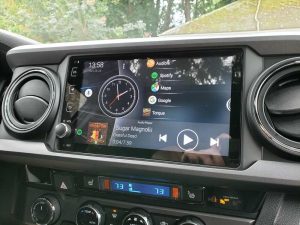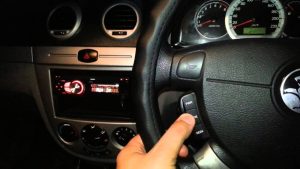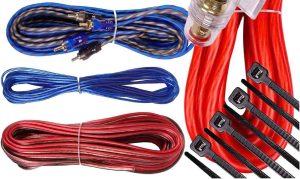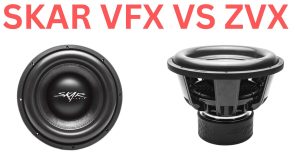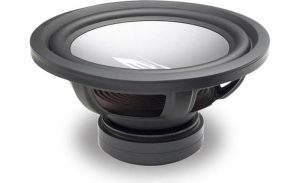The open road stretches before you. Your favorite song comes on. You turn up the volume expecting audio bliss, but instead hear tinny vocals and muddy bass. Sound familiar? Your car’s audio system might be letting you down. The good news? You don’t need to be an audio engineer to transform your daily commute into a concert-quality experience.
Car audio has evolved dramatically since the days of basic AM radio. Today’s systems offer incredible potential for customization, allowing drivers to create personalized soundscapes that rival premium home audio setups. Whether you’re a casual listener or a dedicated audiophile, upgrading your car’s sound system can significantly enhance your driving experience.
Contents
- Understanding Your Current System
- Planning Your Upgrade Path
- Quick Wins: Simple Upgrades With Big Impact
- Going Deeper: Comprehensive System Upgrades
- The Audiophile Approach: Fine-Tuning Your System
- DIY vs. Professional Installation
- System Protection and Maintenance
- The Road Ahead: Future-Proofing Your System
- Conclusion: Your Perfect Soundtrack Awaits
Understanding Your Current System
Before diving into upgrades, take time to understand what you’re working with. Most factory systems include:
- Head unit (the radio/control center)
- Amplifier (either standalone or built into the head unit)
- Speakers (typically four to six, varying in size and location)
- Subwoofer (in some premium factory systems)
Factory audio systems prioritize cost-efficiency over sound quality. Manufacturers often cut corners with basic components that deliver adequate but uninspiring performance. The speakers are usually designed to fit specific spaces rather than produce optimal sound.
Test your current system by playing different music genres. Listen for clarity in vocals, crispness in high frequencies (like cymbals and strings), fullness in midrange tones (guitars and keyboards), and depth in bass notes. Note any distortion at higher volumes or frequencies that seem missing or overpowering.
Planning Your Upgrade Path
Car audio improvements fall into several categories:
- Sound quality upgrades – Better speakers, amplifiers, and sound processing
- Volume and power improvements – More powerful amps and efficient speakers
- Bass enhancement – Subwoofers and proper enclosures
- Source quality improvements – Better head units and digital sources
- Sound treatment – Dampening vibrations and road noise
Your budget and goals will determine which path makes sense. A moderate investment ($300-$500) can dramatically improve sound quality, while enthusiasts might spend several thousand dollars on comprehensive system overhauls.
Quick Wins: Simple Upgrades With Big Impact
Not ready for a complete system replacement? These upgrades deliver significant improvements without breaking the bank:
Speaker Replacement
Factory speakers often use paper cones and basic magnets that deteriorate over time. Replacing them with aftermarket options provides immediate sound quality benefits.
Look for speakers with:
- Polypropylene, woven fiberglass, or composite cones
- Rubber surrounds (rather than foam, which deteriorates)
- Higher sensitivity ratings (measured in dB)
- Extended frequency response
Brands like Polk Audio, JBL, Kicker, and Infinity offer excellent entry-level replacement speakers starting around $50-80 per pair. Installation is straightforward in most vehicles—many speakers are designed as direct drop-in replacements for factory units.
Sound Dampening Materials
Road noise and vibrations can mask subtle audio details and create irritating rattles. Apply sound dampening material to your doors, floor, and trunk to create a quieter listening environment. Products like Dynamat, Noico, and Kilmat use butyl-based compounds that reduce vibrations and block outside noise.
Benefits include:
- Reduced road and wind noise
- Eliminated door panel rattles
- Improved bass response
- Better sound imaging and clarity
A starter kit covering your front doors might cost $50-100 and takes just a few hours to install.
Digital Signal Processor (DSP)
For tech-savvy listeners, a DSP offers powerful sound shaping capabilities. These devices sit between your head unit and amplifier, allowing precise control over:
- Time alignment (adjusting when sound reaches your ears)
- Equalization (fine-tuning different frequencies)
- Crossover points (directing specific frequencies to appropriate speakers)
Entry-level DSPs start around $150, with professional units reaching $500+. While setup requires some technical knowledge, the sound quality improvements can be transformative.
Going Deeper: Comprehensive System Upgrades
Ready for more significant changes? These upgrades form the backbone of truly exceptional car audio systems:
Amplifier Installation
Factory head units typically provide 15-25 watts per channel—enough to drive speakers at moderate volumes but insufficient for dynamic, distortion-free sound. External amplifiers deliver cleaner power, better dynamics, and improved control over your speakers.
When selecting an amplifier, consider:
- Power output – Aim for 50-75 watts RMS per channel for door speakers
- Channel configuration – 4-channel amps power main speakers; mono amps drive subwoofers
- Class – Class-D amps offer efficiency and compact size; Class-A/B provides excellent sound quality
- Installation requirements – You’ll need power wiring, signal cables, and mounting space
Quality amplifiers start around $150 for a 4-channel model, with high-end options exceeding $1,000. Installation requires routing power from your battery, so many choose professional help for this upgrade.
Subwoofer Addition
Bass frequencies require significant power and specialized speakers to reproduce accurately. Adding a subwoofer completes your sound spectrum and allows main speakers to focus on mid and high frequencies.
Subwoofer systems include:
- The subwoofer driver (8″, 10″, or 12″ are common sizes)
- An enclosure (sealed for tight accuracy or ported for maximum volume)
- A dedicated amplifier (typically 300+ watts RMS)
The type of music you enjoy should influence your subwoofer choice. Jazz and classical benefit from smaller, sealed enclosures with quick response. Electronic and hip-hop fans might prefer larger drivers in ported boxes for maximum impact.
Complete subwoofer packages (driver, box, and amplifier) start around $200-300, with custom options reaching well beyond $1,000.
Head Unit Replacement
Modern head units offer vastly improved features and sound quality compared to factory radios. Benefits include:
- Higher quality digital-to-analog converters
- Better equalization and sound controls
- USB/HD inputs for lossless audio playback
- Smartphone integration via Apple CarPlay or Android Auto
- Bluetooth with advanced audio codecs (aptX, LDAC)
When selecting a new head unit, ensure compatibility with your vehicle’s dashboard dimensions (single DIN or double DIN) and integration with steering wheel controls and vehicle systems.
Quality head units from Pioneer, Kenwood, Alpine, and Sony range from $200 for basic models to $1,000+ for flagship units with advanced features.
The Audiophile Approach: Fine-Tuning Your System
Once you’ve upgraded core components, these refinements help achieve truly exceptional sound:
Component Speaker Systems
Unlike coaxial speakers (with tweeter and woofer combined), component systems separate each driver and include a crossover network to direct frequencies appropriately. This design allows optimal placement of each speaker element—tweeters can go higher on door panels or pillars, while mid-range drivers remain in factory locations.
The result is improved imaging (the perceived location of instruments and vocals) and more natural sound reproduction. Quality component sets start around $150 per pair.
Sound Staging and Imaging
In home audio, speakers create a “soundstage” where instruments appear in specific locations. This is challenging in cars due to asymmetrical listener positioning, but can be addressed through:
- Tweeter placement (A-pillars or sail panels)
- Time alignment (via DSP)
- Strategic equalization
- Center channel addition (in some advanced systems)
Proper setup creates the illusion that music comes from a stage across your dashboard rather than individual speaker locations.
High-Resolution Audio Sources
Even the best speakers can’t improve poor-quality audio files. Upgrade your music sources by:
- Using lossless audio formats (FLAC, ALAC, WAV)
- Streaming at highest available quality (Tidal HiFi, Apple Music Lossless)
- Adding a high-quality digital transport (dedicated audio players)
- Installing a digital-to-analog converter (DAC)
The difference between compressed MP3s and high-resolution audio becomes readily apparent on well-tuned car systems.
DIY vs. Professional Installation
While many upgrades are DIY-friendly, others require specialized tools and expertise. Consider these factors:
DIY-friendly upgrades:
- Basic speaker replacement
- Sound dampening installation
- Simple powered subwoofer addition
- Head unit replacement (in many vehicles)
Professional installation recommended for:
- Complete system design
- Amplifier installation with power wiring
- Custom fabrication work
- Advanced DSP setup and tuning
Professional installation typically adds 30-50% to component costs but includes warranties and expertise that may prove invaluable. Many shops offer free system design consultations to help plan your upgrade path.
System Protection and Maintenance
Protect your investment with proper care:
- Keep volume levels reasonable to prevent speaker damage
- Allow adequate ventilation for amplifiers
- Secure all components to prevent movement
- Clean connections periodically
- Consider a battery upgrade if installing powerful amplifiers
For convertibles or vehicles often parked in public, security features like detachable faceplates or hidden components add peace of mind.
The Road Ahead: Future-Proofing Your System
Car audio technology continues evolving. Consider these trends when planning upgrades:
- Wireless connectivity becoming standard
- Digital signal processing growing more sophisticated
- Integration with vehicle systems becoming deeper
- Alternative energy vehicles introducing new audio challenges and opportunities
Choose components with expansion capabilities and update paths to extend your system’s useful life.
Conclusion: Your Perfect Soundtrack Awaits
Your car represents one of the few environments where you have complete control over the audio experience. With thoughtful upgrades tailored to your preferences and driving habits, every journey can become a sonic adventure.
Start with understanding your current system’s limitations. Make targeted improvements based on your priorities—whether that’s clearer vocals, punchier bass, or immersive soundstaging. Remember that even modest investments can yield significant improvements when applied strategically.
The ultimate car audio system isn’t about brand names or price tags—it’s about creating a listening experience that makes every drive more enjoyable. With the guidelines outlined here, you’re well on your way to revving up your ride’s audio potential. The open road awaits—what will be on your playlist?

